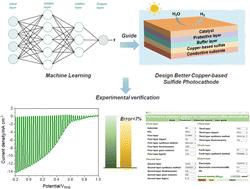机器学习辅助设计高性能硫化铜光电阴极
IF 10.7
2区 材料科学
Q1 CHEMISTRY, PHYSICAL
引用次数: 0
摘要
铜基硫化物光电阴极具有窄带隙、高吸收系数和良好的载流子传输特性,在太阳能水分离应用中表现出令人瞩目的性能。成分、厚度和掺杂等几个因素对起始电位、光电流密度和太阳能制氢效率有直接影响。在存在多种变量的情况下筛选最佳组合无疑是一项具有挑战性的任务。然而,构建全面的数据库、开发光电阴极模型并利用机器学习得出最佳结果,显然可以节省大量的实验工作。这种方法有效地减少了实验工作量,简化了流程,加快了光电化学水分离应用领域高性能材料的开发。在此,我们介绍一种全面的机器学习流程,用于指导铜基硫化物光电阴极的制备。我们选择随机森林模型来训练和捕捉硫化铜基光电阴极不同层和电解质之间的复杂关系,以预测未研究的条件,测试集的准确率达到 96.7%。通过 SHAP 可解释性分析,我们提供了启发式规则,加深了对不同因素对催化系统性能影响的理解。我们还开发了一个预测平台来共享我们的预测模型。本文章由计算机程序翻译,如有差异,请以英文原文为准。

Machine learning aided design of high performance copper-based sulfide photocathodes
Copper-based sulfide photocathodes have shown impressive performance in solar water splitting applications due to their narrow bandgaps, high absorption coefficients, and good carrier transport properties. Several factors, such as composition, thickness, and doping, have a direct influence on the onset potential, photocurrent density, and solar-to-hydrogen efficiency. Screening for the optimal combination in the presence of multiple variables is undoubtedly a challenging task. However, constructing a comprehensive database, developing photocathode models, and utilizing machine learning to derive the best results clearly save a significant amount of experimental effort. This approach efficiently reduces the experimental workload, streamlines the process, and expedites the development of high-performance materials for photoelectrochemical water splitting applications. Here, we introduce a comprehensive machine learning process to guide the preparation of copper-based sulfide photocathodes. The random forest model was selected to train and capture the complex relationship between different layers of copper-based sulfide photocathodes and electrolytes to predict unstudied conditions, and the accuracy of the test set reached 96.7%. Through SHAP interpretability analysis, we provide heuristic rules to deepen the understanding of the influence of different factors on the performance of the catalytic system. We also developed a prediction platform to share our prediction models.
求助全文
通过发布文献求助,成功后即可免费获取论文全文。
去求助
来源期刊

Journal of Materials Chemistry A
CHEMISTRY, PHYSICAL-ENERGY & FUELS
CiteScore
19.50
自引率
5.00%
发文量
1892
审稿时长
1.5 months
期刊介绍:
The Journal of Materials Chemistry A, B & C covers a wide range of high-quality studies in the field of materials chemistry, with each section focusing on specific applications of the materials studied. Journal of Materials Chemistry A emphasizes applications in energy and sustainability, including topics such as artificial photosynthesis, batteries, and fuel cells. Journal of Materials Chemistry B focuses on applications in biology and medicine, while Journal of Materials Chemistry C covers applications in optical, magnetic, and electronic devices. Example topic areas within the scope of Journal of Materials Chemistry A include catalysis, green/sustainable materials, sensors, and water treatment, among others.
 求助内容:
求助内容: 应助结果提醒方式:
应助结果提醒方式:


